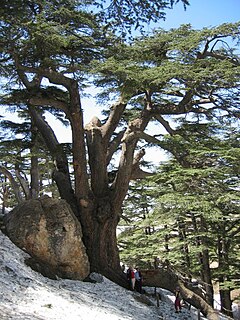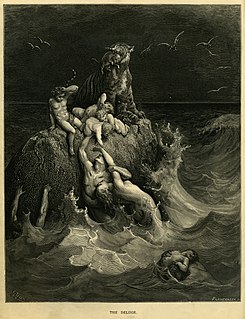Related Research Articles

Gilgamesh was a major hero in ancient Mesopotamian mythology and the protagonist of the Epic of Gilgamesh, an epic poem written in Akkadian during the late 2nd millennium BC. He was also most likely a historical king of the Sumerian city-state of Uruk, who was posthumously deified. His rule probably would have taken place sometime between 2900 and 2500 BC, though he became a major figure in Sumerian legend during the Third Dynasty of Ur.

In the traditions of Abrahamic religions, Noah features as the tenth and last of the pre-Flood patriarchs. His story appears in the Hebrew Bible and in the Quran. The Genesis flood narrative is among the best-known stories of the Bible. Noah is also portrayed as a "tiller of the soil" and as a drinker of wine.

Inanna is an ancient Mesopotamian goddess associated with love, beauty, sex, war, justice and political power. She was originally worshiped in Sumer under the name "Inanna", and was later worshipped by the Akkadians, Babylonians, and Assyrians under the name Ishtar. She was known as the "Queen of Heaven" and was the patron goddess of the Eanna temple at the city of Uruk, which was her main cult center. She was associated with the planet Venus and her most prominent symbols included the lion and the eight-pointed star. Her husband was the god Dumuzid and her sukkal, or personal attendant, was the goddess Ninshubur.

The Epic of Gilgamesh is an epic poem from ancient Mesopotamia, regarded as the earliest surviving great work of literature and the second oldest religious text, after the Pyramid Texts. The literary history of Gilgamesh begins with five Sumerian poems about Bilgamesh, king of Uruk, dating from the Third Dynasty of Ur. These independent stories were later used as source material for a combined epic in Akkadian. The first surviving version of this combined epic, known as the "Old Babylonian" version dates to the 18th century BC and is titled after its incipit, Shūtur eli sharrī. Only a few tablets of it have survived. The later Standard Babylonian version compiled by Sîn-lēqi-unninni dates from the 13th to the 10th centuries BC and bears the incipitSha naqba īmuru. Approximately two-thirds of this longer, twelve-tablet version have been recovered. Some of the best copies were discovered in the library ruins of the 7th-century BC Assyrian king Ashurbanipal.

Utu, later worshipped by the East Semitic Akkadian-speaking Assyrians and Babylonians as Shamash, was the ancient Mesopotamian sun god, god of justice, morality, and truth, and the twin of the Mesopotamian goddess Inanna, the Queen of Heaven. His main temples were in the cities of Sippar and Larsa. He was believed to ride through the heavens in his sun chariot and see all things that happened in the day. He was the enforcer of divine justice and was thought to aid those in distress. According to Sumerian mythology, he helped protect Dumuzid when the galla demons tried to drag him to the Underworld and he appeared to the hero Ziusudra after the Great Flood. In the Epic of Gilgamesh, he helps Gilgamesh defeat the ogre Humbaba.

In Ancient Mesopotamian religion, Humbaba, also spelled Huwawa and surnamed the Terrible, was a monstrous giant of immemorial age raised by Utu, the Sun. Humbaba was the guardian of the Cedar Forest, where the gods lived, by the will of the god Enlil, who "assigned [Humbaba] as a terror to human beings. Gilgamesh and Enkidu defeated this great enemy."

Mount Hermon is a mountain cluster constituting the southern end of the Anti-Lebanon mountain range. Its summit straddles the border between Syria and Lebanon and, at 2,814 m (9,232 ft) above sea level, is the highest point in Syria. On the top, in the United Nations buffer zone between Syrian and Israeli-occupied territories, is the highest permanently manned UN position in the world, known as "Hermon Hotel", located at 2814 metres altitude. The southern slopes of Mount Hermon extend to the Israeli-occupied portion of the Golan Heights, where the Mount Hermon ski resort is located with a top elevation of 2,040 metres. A peak in this area rising to 2,236 m (7,336 ft) is the highest elevation in Israeli-controlled territory.

Cedrus libani, the cedar of Lebanon or Lebanon cedar, is a species of tree in the pine family Pinaceae, native to the mountains of the Eastern Mediterranean basin. It is a large evergreen conifer that has great religious and historical significance in the cultures of the Middle East, and is referenced many times in the literature of ancient civilisations. It is the national emblem of Lebanon and is widely used as an ornamental tree in parks and gardens.

A flood myth or deluge myth is a myth in which a great flood, usually sent by a deity or deities, destroys civilization, often in an act of divine retribution. Parallels are often drawn between the flood waters of these myths and the primaeval waters which appear in certain creation myths, as the flood waters are described as a measure for the cleansing of humanity, in preparation for rebirth. Most flood myths also contain a culture hero, who "represents the human craving for life".

Anzû, also known as dZû and Imdugud, is a lesser divinity or monster in several Mesopotamian religions. He was conceived by the pure waters of the Apsu and the wide Earth, or as son of Siris. Anzû was depicted as a massive bird who can breathe fire and water, although Anzû is alternately depicted as a lion-headed eagle.

Enkidu (𒂗𒆠𒄭EN.KI.DU10), was a legendary figure in ancient Mesopotamian mythology, wartime comrade and friend of king Gilgamesh. Their exploits were composed in Sumerian poems and in the Akkadian Epic of Gilgamesh, written during the 2nd millennium BC. He is the oldest literary representation of the wild man, a recurrent motif in artistic representations in Mesopotamia and in Ancient Near East literature. The apparition of Enkidu as a primitive man seems to be an innovation of the Old Babylonian version (1300 - 1000 BC), as he was originally a servant-warrior in the Sumerian poems.

Atra-Hasis is an Akkadian epic, recorded in various versions on clay tablets, named for its protagonist, Atrahasis. The Atra-Hasis tablets include both a creation myth and one of three surviving Babylonian flood myths. The name "Atra-Hasis" also appears, as king of Shuruppak in the times before a flood, on one of the Sumerian King Lists.

Lugalbanda is a character found in Sumerian mythology and literature. Lugalbanda is listed in the Sumerian King List as the second king of Uruk, saying he ruled for 1,200 years, and providing him with the epithet of "the Shepherd". Lugalbanda's existence and rule, whether a king who historically ruled over Uruk and at what time, is quite uncertain. Attempts to date him in the ED II period are based on an amalgamation of data from the epic traditions of the 2nd millennium with unclear archaeological observations.

Siduri is a character in the Epic of Gilgamesh. She is an "alewife", a wise female divinity associated with fermentation.

The Cedar Forest is the glorious realm of the gods of Mesopotamian mythology. It is guarded by the demigod Humbaba and was once entered by the hero Gilgamesh who dared cut down trees from its virgin stands during his quest for fame. The Cedar Forest is described in Tablets 4-6 of the great Epic of Gilgamesh.

The Gilgamesh flood myth is a flood myth in the Epic of Gilgamesh. Many scholars believe that the flood myth was added to Tablet XI in the "standard version" of the Gilgamesh Epic by an editor who used the flood story from the Epic of Atrahasis. A short reference to the flood myth is also present in the much older Sumerian Gilgamesh poems, from which the later Babylonian versions drew much of their inspiration and subject matter.

Hubur is a Sumerian term meaning "river", "watercourse" or "netherworld", written ideographically with the cuneiform signs 𒄷𒁓. It is usually the "river of the netherworld".
The earliest record of a Sumerian creation myth, called The Eridu Genesis by historian Thorkild Jacobsen, is found on a single fragmentary tablet excavated in Nippur by the Expedition of the University of Pennsylvania in 1893, and first recognized by Arno Poebel in 1912. It is written in the Sumerian language and dated to around 1600 BCE. Other Sumerian creation myths from around this date are called the Barton Cylinder, the Debate between sheep and grain and the Debate between Winter and Summer, also found at Nippur.

The concept of a Garden of the gods or a divine paradise may have originated in Sumer. The concept of this home of the immortals was later handed down to the Babylonians who conquered Sumer.

In ancient Mesopotamian mythology, the Bull of Heaven is a mythical beast fought by the hero Gilgamesh. The story of the Bull of Heaven has two different versions: one recorded in an earlier Sumerian poem and a later version in the standard Akkadian Epic of Gilgamesh. In the Sumerian poem, the Bull is sent to attack Gilgamesh by the goddess Inanna for reasons that are unclear. The more complete Akkadian account comes from Tablet VI of the Epic of Gilgamesh, in which Gilgamesh rejects the sexual advances of the goddess Ishtar, the East Semitic equivalent of Inanna, leading the enraged Ishtar to demand her father Anu for the Bull of Heaven, so that she may send it to attack Gilgamesh in Uruk. Anu gives her the Bull and she sends it to attack Gilgamesh and his companion, the hero Enkidu, who slay the Bull together.
References
- ↑ P. T. H. Unwin; Tim Unwin (18 June 1996). Wine and the Vine: An Historical Geography of Viticulture and the Wine Trade. Psychology Press. pp. 80–. ISBN 978-0-415-14416-2 . Retrieved 31 May 2011.
- ↑ Trample, Christopher "A Maiden Guards the Door: Symbolism and Meaning in Mythology" (http://www.public.iastate.edu/~ctrampel/Trampel_Mythology_Journal_Format2.pdf%5B%5D), accessed 02.09.2013
- ↑ Jeffrey H. Tigay (November 2002). The evolution of the Gilgamesh epic. Bolchazy-Carducci Publishers. pp. 76–78. ISBN 978-0-86516-546-5 . Retrieved 29 June 2011.
- Jennifer Westwood: Gilgamesh & Other Babylonian Tales, New York: Coward-McCann, 1968.
| This article relating to a myth or legend from the ancient Middle East is a stub. You can help Wikipedia by expanding it. |
